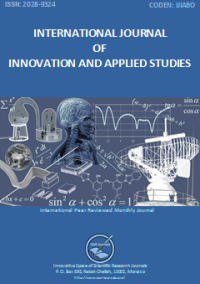-
1. Publication Fee
- Publication fee for each accepted article is $80 USD (2130 INR for Indian authors).
2. Submission Process
- Manuscript should be made in the light of Journal’s author guidelines.
- Submissions are accepted through the online submission system on: http://www.ijias.issr-journals.org/submit.php
3. Submission Preparation Checklist
Before submitting the manuscript, author(s) should check the following list.
- Submission of a manuscript to IJIAS indicates an understanding that the paper is not under consideration for publications with other journals.
- The submission has not been copied or plagiarized in whole or in part from other works.
- Articles are accepted only in MS-Word format. No pdf files are accepted.
- Please submit your article in only one file (.doc or .docx) including results, tables, figures, references and the text.
- Submitted papers should strictly follow the format of the sample article. Please click here for the sample article.
4. Manuscript Preparation
-
4.1. Language
- Papers can be written in English, French, Spanish or Arabic.
4.2. Title
- Title should be concise and informative.
- If the manuscript is in a language other than English, It should include an English version of the title.
- Try to avoid abbreviations, special characters, math and formulae where possible.
4.3. Author’s names and affiliations
- The submitted article should include the name(s) and the affiliation(s) of the author(s).
- Please:
- Indicate the given name and family name clearly.
- Present the authors' affiliation addresses (where the actual work was done) below the names.
- Provide the full postal address of each affiliation, including the country name, and, if available, the e-mail address of each author.
4.4. Corresponding author
- Clearly indicate who is willing to handle correspondence at all stages of refereeing, publication and also post-publication.
4.5. Abstract
- Each manuscript must include an abstract in English of approximately 200-250 words.
- It should be concise and factual.
- It should have a structured form.
- The abstract should state briefly the purpose of the research, the principal results and major conclusions.
- An abstract is often presented separate from the article, so it must be able to stand alone.
- References should be avoided in the abstract.
- Do not use abbreviations, special characters, math and formulae in your abstract.
4.6. Keywords
- Immediately after the abstract, provide a maximum of 8 keywords, avoiding general and plural terms and multiple concepts (avoid, for example, 'and', 'of').
- Try to provide at least 5 keywords.
- Key words should not repeat the title of the manuscript.
4.7. Subdivision of the article
- Divide your article into clearly defined and numbered sections.
- Subsections should be numbered 1, 2. (then 1.1, 1.1.1, 1.1.2), 1.2, etc.
- The abstract is not included in section numbering.
- Research works should be divided into background, material and methods, results, discussion, conclusions, references.
4.8. Acknowledgment
- This unnumbered section is used to identify people who have aided the authors in accomplishing the work presented and to acknowledge sources of funding.
4.9. References
You can use [Zotero] a free, easy-to-use tool to help you collect, organize, and cite your research sources.
- Citations in the text
- Please ensure that every reference cited in the text is also present in the reference list (and vice versa).
- Avoid citation in the abstract.
- Citation of a reference as 'in press' implies that the item has been accepted for publication.
- Citations in the text should be marked consecutively by Arab numbers in brackets (e.g. [1]).
- When referring to a reference item, please simply use the reference number, as in [2].
- Do not use “Ref. [3]” or “Reference [3]” except at the beginning of a sentence, e.g. “Reference [3] shows …”.
- Multiple references are each numbered with separate brackets (e.g. [2], [6], [7], [8], [9]).
- Reference List
- The heading of the References section must not be numbered.
- Unpublished results should not be in the reference list, but may be mentioned in the text.
- References should be presented in consecutive order (as they are referred to in the text).
- Number the reference items consecutively in square brackets (e.g. [1]).
- Examples:
- Reference to a journal publication:
- [1] S. K. Srivastava and K. Kaur, “Stability of Impulsive Differential Equation with any Time Delay,” International Journal of Innovation and Applied Studies, vol. 2, no. 3, pp. 280–286, 2013.
- [2] O. V. ADEOLUWA, O. S. ABODERIN, and O. D. OMODARA, “An Appraisal of Educational Technology Usage in Secondary Schools in Ondo State (Nigeria),” International Journal of Innovation and Applied Studies, vol. 2, no. 3, pp. 265–271, 2013.
- Reference to a book:
- [10] Balanis, Antenna Theory: Analysis and Design, 2nd Ed. Wiley India Pvt. Limited, 2007.
- [11] C. Tichi, Electronic Hearth: Creating an American Television Culture. Oxford University Press, 1991.
- [12] A. R. Jennings, Financial Accounting. Cengage Learning EMEA, 2001.
- Reference to a chapter in an edited book:
- [7] Mettam, G. R., and Adams, L. B., How to prepare an electronic version of your article, In: B. S. Jones, and R. Z. Smith (Eds.), Introduction to the electronic age, New York: E-Publishing Inc, pp. 281-304, 1994.
- [8] O'Neil, J. M., and Egan, J., Men's and women's gender role journeys: A metaphor for healing, transition, and transformation, In: B. R. Wainrib (Ed.), Gender issues across the life cycle, New York, NY: Springer, pp. 107-123, 1992.
- Reference to a web source:
- [5] Smith, Joe, One of Volvo's core values, 1999. [Online] Available: http://www.volvo.com/environment/index.htm (July 7, 1999)
- Reference to a journal publication:
- Papers can be written in English, French, Spanish or Arabic.


Twitter

Facebook

Google+

VKontakte
LinkedIn


Viadeo
English
Français
Español
العربية












